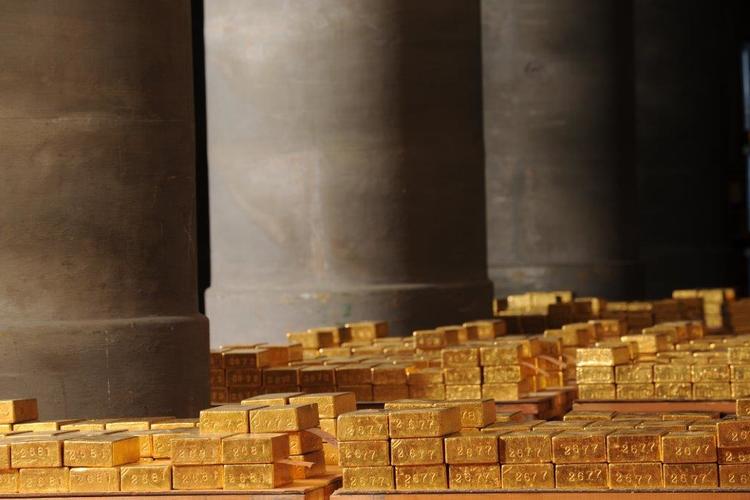Custody and management of gold
One of the core tasks entrusted to the Banque de France under the Monetary and Financial Code is the storage and management of the national gold reserves. The Banque de France also provides gold custodian services to other central banks around the world.
Share links

The Banque de France’s gold reserves
The size of the gold reserves is 2,435 tonnes, which in 2015 were valued at EUR 76.2 billion.
The Banque de France is the 4th largest custodian of gold, after the United States Federal Reserve and the central banks of Germany and Italy.
The last sales of gold took place between 2005 and 2009 as part of the Second Washington Agreement under which central banks agreed on a concerted programme of sales at a time when the gold price was particularly low. (On 4 January 2005, the price stood at EUR 320.124/ounce, and on 30 September 2009 it was EUR 682.628/ounce; in comparison, the price on 1 July 2016 was EUR 1202.918/ounce. Source LBMA.)
Gold accounts for some 70% of the Banque de France’s foreign exchange reserves; the remainder is made up of foreign currencies such as the dollar and yen.
Storage of gold in Paris
The gold reserves are stored in the underground vault “La Souterraine”, a highly secure, 1,000 m² hall located 27 m below ground level. The Banque de France is responsible for maintaining the integrity of the gold reserves, and ensuring that they can be traded on international markets. In order to be tradable, gold bars must meet the standards of the London Bullion Market Association (LBMA), a professional body set up in 1987.
To find out more

Les secrets de l'or (gold’s secrets)
Written by Didier Bruneel, former Director General at the Banque de France and historical advisor to the Governor Where is the gold kept? How is it protected? How are gold ingots made? How is gold transferred from one bank to another? What happened to the gold reserves during the World Wars?
FAQ
Buying/selling gold, a guide for private individuals: coins, ingots, where to buy gold, taxes.
The Banque de France does not buy gold from or sell to private individuals.
Legal texts governing the purchase/sale of gold
Monetary and Financial Code
Article L. 426-1
The holding, transportation and trading of gold are unregulated in France.
Article L. 152-1
Natural persons who transfer more than EUR 10,000 of gold to or from a European Union Member State, without using a credit institution, an electronic money institution, a payment institution (…), must make a declaration to the customs authorities.
Article L. 342-1
Canvassing and direct marketing with a view to selling, buying or exchanging gold in the form of ingots, bars, foreign currencies or demonetised gold coins is prohibited.
Whoever goes to the domicile of private individuals, other than bankers, brokers, traders in precious metals, or to public places not designated for such use, to sell or purchase the aforementioned items, with immediate delivery and payment, in whole or in part, for cash or for securities, is engaged in canvassing.
Article D. 514-8
Pawn loans secured by goods made of platinum, gold or silver may not exceed four fifths of the value of the collateral, estimated according to its weight. For other types of collateral, the loan may not exceed two thirds of their estimated value.
Sales of gold are subject to specific tax requirements.
General tax code
VII quater: Duty on precious metals, jewellery, works of art, collectibles and antiques.
Article 150 VI
Amended by Law No 2013-1278 of 29 December 2013 - Art. 19 (V)
I.-Notwithstanding the specific provisions applicable to business profits, transfers in return for remuneration or non-temporary exports of the following items to countries that are not European Union Member States are subject to the flat-rate tax specified in Articles 150 VJ to 150 VM:
1 Precious metals;
2 Jewellery, works of art, collectibles and antiques.
II.-The provisions of paragraph I also apply to sales in other European Union Member States.
NB: Budget Law No 2013-1278 of 29 December 2013 for 2014, Art. 19 III: The aforementioned provisions apply to sales and exports of goods carried out as of 1 January 2014.
Article 150 VK
Amended by Law No 2013-1278 of 29 December 2013 - Art. 19 (V)
I.-The tax charge is incurred by the seller or exporter. It is paid, under the seller or exporter’s responsibility, by the French-domiciled intermediary participating in the transaction or, in the absence of an intermediary, by the buyer, if the latter is subject to French value added tax. In all other cases it is paid by the seller or exporter.
II.-The tax charge is equal to:
1 10% of the sale price or of the customs value of the goods mentioned in item 1° of paragraph I of Article 150 VI;
2 6% of the sale price or customs value of the goods mentioned in item 2° of paragraph I of Article 150 VI.
III.-The tax is payable at the time of sale or of export.
NB:
Budget Law No 2013-1278 of 29 December 2013 for 2014, Art. 19 III: The aforementioned provisions apply to sales and exports of goods carried out as of 1 January 2014.
Article 150 VL
Amended by Law No 2013-1278 of 29 December 2013 - Art. 19 (V)
The seller or exporter can opt for the tax regime described in Article 150 UA provided they can provide proof of the date of acquisition and purchase price of the good or prove that it has been held for more than 22 years. In this case, the flat-rate tax described in Article 150 VI is not due.
NB: Budget Law No 2013-1278 of 29 December 2013 for 2014, Art. 19 III: The aforementioned provisions apply to sales and exports of goods carried out as of 1 January 2014.
Updated on: 03/19/2019 16:55

